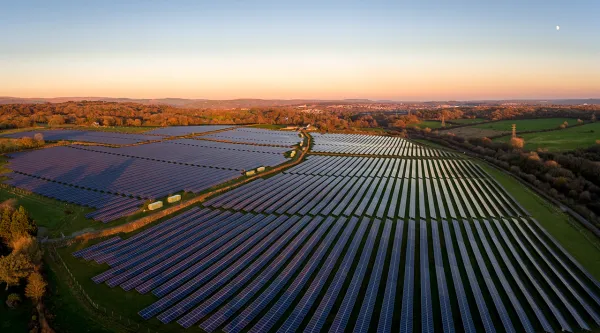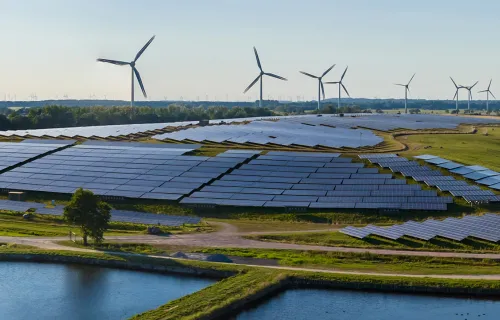With the increasing focus on renewable energy, I wanted to look at the current challenges facing energy companies across the different types of energy. Renewable energy generation faces many challenges, such as the high costs and complexity of managing construction, infrastructure, power storage, and maintenance. All this is underpinned by a lack of government policy and subsidy. In this blog I’ll explore how these challenges vary across different types of renewable energy - wind, solar, and hydrogen.
Welcoming wind power
There is a significant amount of investment going into offshore wind power. A recent article forecasts the global installed offshore wind capacity is expected to reach 630 gigawatts by 2050, which is up from only 40 gigawatts only a couple of years ago. So, what’s driving this growth?
There is an obvious advantage of space. The oceans provide the perfect location to build wind farms in terms of scale and openness. Higher wind speeds and consistency in the direction of the wind at specific offshore locations are also driving interest in offshore wind power generation.
Floating offshore wind is now becoming a major topic. Unlike traditional seabed-fixed bottom turbines, floating wind turbines don't need to be grounded in the seabed. This means they can be sited much further out to sea in deeper water where the winds are even stronger, so there’s potential for greater generation of energy. Floating offshore wind will be able to build on the developments made by the seabed-fixed offshore wind to reach scale even faster; however this won't be without its challenges.
Investment and government backing will be crucial to really ensure that capacity grows in a sustainable way. Also, we need to remember, having the right technology available is crucial to support the operation of wind farms, but also to leverage the data that will be available. And wind is only one part of the puzzle…
A place in the sun
Solar farms and photovoltaic cells have seen significant investment across many countries and commercial organisations across the world. Businesses, both within and outside the energy sector, have started tapping into solar energy in a variety of ways including installing solar panels on their facilities. Commercial businesses, who have large data centre facilities see the installation of solar panels and the power they generate as a good way to offset some of their carbon footprints. Many homes and non-commercial buildings are also increasing using solar power. However, solar power is not without challenges either.
The biggest challenge for solar energy generation is stability with the obvious fact that the sun doesn't shine everywhere all the time. The efficiency of solar panels is ever improving, but they can still only function when there is adequate sunlight. There is also the challenge of managing the energy generated and consumed from solar power. And if there is any excess, how do we store it?
This is where hybrid assets and plants come in. Hybrid plants use different combinations of energy production and storage such as wind and solar, wind and storage, solar and storage, etc. These hybrid plants have many benefits when compared to a pure wind farm, or a pure solar farm, or any other kind of pure renewable power plants. They have the potential to provide an optimal combination of solar, wind and storage to deliver stable power round the clock.
The hydrogen rainbow
Currently topping the charts for alternative and renewable energy sources is hydrogen power - many organisations and initiatives are considering whether hydrogen could potentially replace current fossil fuels altogether.
Hydrogen is often referred to in terms of colour, which is based on the source of the energy used to produce the hydrogen. For example: black hydrogen uses black coal, brown hydrogen uses brown coal, and grey hydrogen uses gas. These non-renewable hydrogens are cheap to produce but also create carbon dioxide as a by-product which is released into the atmosphere, causing pollution. When creating grey hydrogen (using gas) the carbon dioxide can be captured and stored underground, and this is known as blue hydrogen which is carbon neutral. But capturing and storing hydrogen is difficult and expensive.
This is why the hydrogen industry is focusing largely on green hydrogen. With green hydrogen, the energy used to produce the hydrogen comes from green (renewable) energy sources, like solar or wind. This green hydrogen only produces water as a by-product, so it is truly renewable and carbon neutral. The industry is exploring different combinations to maximise the different renewable energy sources used to produce green hydrogen. Organisations are working on a hydrogen value chain, from production to transportation and consumption of hydrogen.
While hydrogen power seems promising, it has its own challenges. For example, transporting hydrogen via commercial roads requires wide vehicles which is logistically difficult, and while rail transportation provides a larger storage area for safer transportation, this is also challenging and expensive. The challenges facing hydrogen power remain across storage, distribution, and consumption.
Road to a more sustainable future
Whilst different types of renewable energy face different challenges, technology will likely play a key role in addressing them all. The energy sector must welcome digital transformation and utilise the power of data to address and overcome challenges in energy generation. Success now, focuses on transitioning from the conventional fossil-fuels based value chain to a power-based value chain.
Get in touch to discuss the role of renewables in your organisation.
Keep an eye out for our next blog on the renewable energy journey “Data - bridging the gap between the conventional and renewable”.




